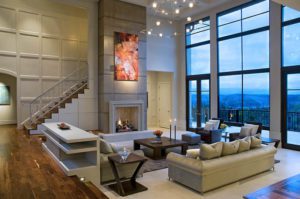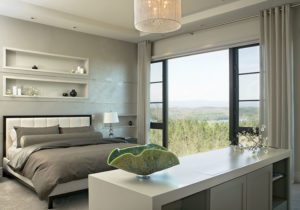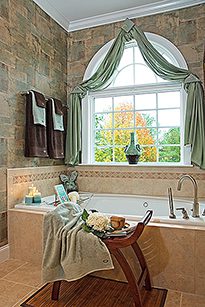Everything You Ever Wanted To Know About a Photo Shoot
From the Photographer’s Point of View
There are a few things that set us apart from other photographers. First, we understand the time and personal involvement that an interior designer puts into each project. We feel that interior design is an art, and when we walk into a room we are seeing that designer’s work of art. We want to take the best possible photograph of the home the way the designer created it.
Second, we have an extensive background in the furniture industry and have worked for many years with interior designers. That gives us a wealth of knowledge and insights that other photographers just don’t have. Another area where we have tried to separate ourselves from other photographers is in our fees. We know photography is typically a rather large expense and that many designers assume they will spend a small fortune for 2 or 3 finished shots. We do our best to keep our costs reasonable and we always try to work within your budget.

What you do is similar to what we do. You look at a room and
see a blank canvas. You create the image in that room. It’s your vision, your work of art. So you should care what your portfolio says about your work and want to show it at its best advantage with good photography. We feel the same way…we want good photography in our portfolio. You’ve created something beautiful, we capture that beauty, and we both end up with something we’re proud of. There is a marriage between your creativity and ours that benefits us both.
The Big Deal About Great Photography
It isn’t by chance that photos in a magazine look all warm & cozy or light & airy. What feeling do you want to evoke? It’s achieved with the color temperature of the lights. “Feeling” the shot is the key. Just like portrait photography, you don’t get the feeling by just pointing a camera at your subject and popping a flash. It’s all about balance, creating soft shadows to show details instead of creating a flat image. If the lighting is done properly, it will look like it’s supposed to be in Better Homes & Gardens.
Depth of field is an important factor in good photography. Bring focus to a certain part of the room by letting some things fall out of focus. When you look at images where this has been done, your mind puts the rest of the image together but isn’t distracted from the main focal point. If we photograph a room so that it looks inviting, your potential customer will look at it and feel the urge to step into that room. That’s what we want to evoke. That’s what you want them to feel too, because then they will want you to create a room with that feel for them. The best shots just aren’t always there immediately. You have to shoot & look, rearrange, pick a different angle, shoot & look again. For example, when we shot a bathroom in a model home at The Gardens in Charlotte, NC, we shot a couple of images, the designer looked at them & inspiration hit her…she added a magazine on the ottoman & stuck a decorative object in an empty spot. Then inspiration hit Jeff and he suggested lighting the candles, and made me climb on a countertop with a light box in hand so the lighting would be exact. It all came together & we all knew it when we saw the shot .The feeling was there. We made the room look like someone was preparing for a leisurely soak and had to step out to answer the phone.
We all love to look at photographs of other peoples homes. We love to imagine ourselves living there, imagine what we could do to make
One particular problem in photographing a room setting is that your eye sees the room in full dimension. Round objects look round, your eye sees the objects that are behind other objects as two separate things with space in between…the camera sees everything flat, so objects have a tendency to look as if one object is growing out of the other. Sometimes this can be corrected by a slight shift of the camera angle, other times it is necessary to move one of the objects to simplify the view. Another commonly overlooked detail is the furniture itself. Sofa cushions need to be fluffed, welt cords need to be straightened a bit, and pillows need to be arranged. A chair may need to have a few loose threads clipped, or be angled slightly differently. These are details we notice because of our furniture background, and we can help you make those fine adjustments that make all the difference in the world.

a room in our home look like that, and imagine what the rest of the home looks like. And we appreciate the beauty that someone has taken the time to create. We are seeing the self-expression of the decorator and recognizing a statement about the people who live there, too. The art of the photographer is to capture and convey the visual story each room tells and to welcome the viewer into the room to admire it. A good interior photographer doesn’t just document the items in a room, he discovers the point of view that brings all those things together. He finds the best method of lighting to convey the decorator’s artistry. Sometimes it’s done with natural light, letting sunlight dance across items in a room to bring attention to them. Other times it’s done with intriguing shadows to entice the viewer to take a closer look. Warm highlights glowing off the rich wood of an antique…bounced light from a soft box to gently accentuate the clean crisp linens on a bed…the glow of a lighted lamp to suggest that someone just left the room and will be back shortly. All these things run through the photographer’s mind long before the first click of the camera.
So many details go into making a truly great interior shot, and that is the reason it is so important to choose a photographer with the knowledge and ability to see all these things. Anyone with a camera can take a picture of a room & show the contents, but it takes someone with a creative eye to transform the shot into a story.

What You Need To Know, Room by Room
The first thing to remember is since we’re already there with all the right equipment, don’t forget to get a little vignette shot if possible. It can be a small object, like a particularly unusual art object that you spent a month hunting for, a collection of antiques or a couple of unique pillows on the bed. Sometimes this shot, incorporated into your portfolio, can really add splash and impress whoever is looking at your body of work. The second thing to always remember is light bulbs—always bring a bag of them. Bring a mixture of wattages so you can be prepared to add or subtract the lamp light in any given room. The third thing is don’t rush! Rome wasn’t built in a day and this gorgeous room isn’t going to get photographed in 15 minutes. When you schedule a shoot with us, make sure you give all of us the time to do a good job. When you’re pressed for time, that’s when things get overlooked. If you’ve ever looked at a photograph and said “I wonder why they didn’t fix that lamp shade?”, now you know why.

Bathroom:
This is sometimes a tricky little room. There is just no way to avoid the toilet in most bathrooms. If you can find a way around showing it, do. And if it is just unavoidable, lessen the affront by placing a stack of neatly folded towels on top of it. Occasionally it works to do a “through the mirror” shot in a bathroom, but not often. When it does work, it lends a nice, spacious look to the room. Props can include a bathrobe, towels, a natural sponge, a bath brush, soap dish with small, attractive soaps or toothbrush holder if especially unique, minimal floral touches, and sometimes candles work well.
Kitchen:
This is typically the spot in most homes where people congregate the most. If you want to capture that lively socializing feel without people in it, a little preparation is in order. Start by taking away most items on the countertops and begin adding props back into the scene. You want to create the illusion that someone was just there and will be back momentarily. Props can include fruits & veggies to add color, if very fresh or well-made artificial. Avoid overdoing the herb & oil bottles, foods, pastas, etc. It’s a kitchen, not a supermarket. Attractive & colorful tableware, flatware, utensils…use sparingly so as not to create clutter. Make sure napkins are fresh & look new. Make sure tablecloths & placemats look new and aren’t dirty or overly wrinkled. Flowers or herb bunches are a nice touch. A tea kettle, if distinctive, can take away from the bareness of a stovetop. If the homeowner has a nice collection of pottery, try to incorporate it into the shot.


Bedroom:
This is the place of rest & dreams. This is also the place where the largest expanse of fabric will probably be. Bed covers should look comfortable, but an abundance of wrinkles makes it look sloppy. Sometimes the bed will look so huge in a photograph that it is best to shoot at another object in the room and only include part of the bed in the shot. A big problem for the camera is a huge bed in a small room. The bed always looks distorted. We feel it’s better to get the feel of the room and not try to show the whole thing. If possible, remove the telephone, answering machine, clock radio/alarm clock, etc., and replace them with a bud vase. Props can include linens, blankets, throws (but keep them simple). Pillows fluffed nicely, a floral arrangement or small vase of flowers in keeping with the room’s character is always nice. The water glass on the nightstand is ok but make sure it’s clean and has some distinctive character. Small photo frames work well here.
Dining room:
Resist the urge to set up all the plates, glasses & flatware at a formal dining table for eight. It’s just too much information for the eye to take in. Put a stack of plates, a row of forks and a few goblets on one corner instead. It gives the illusion that someone was about to prepare the table and went back into the kitchen for something. If necessary, take out a chair or two in order to eliminate some of the jumble of legs under the table. Remember, quality beats quantity every time! Props can include flowers, table linens, dishes, food is optional here & only if very attractive (ironically fake is best). A vase of two or three floral stems and two candles on top of a beautiful wood surface is sometimes all you need.


Living Room:
The key here is to capture the feel of comfort, the invitation to come in and sit down, and to show off the pure beauty of your work. This room is typically the showpiece of the home. And often you can say it best in a photograph by only showing part of the room. Generally speaking, you want a couple of different viewpoints shot in the living room, but every shoot is different and there’s no need to wear yourself out with an angle that just doesn’t work. Props can include flowers, vases, pillows & throws to add texture and color, small accessories, books—but don’t overdo it or it will distract. Preparing a room for photography means finding that perfect balance between not enough and too much. The camera cannot translate as many objects as the eye can see.

A word about homeowners:
The best photo shoots you will ever have are the ones where the homeowner hands you the key & says “we’ll be back tomorrow, lock up when you’re through, will you?” The reason is simple. They will always want to incorporate something personal or sentimental into the shot that just shouldn’t be there. And you will end up spending all your time trying to get their favorite items out of the shot without hurting their feelings. If they have children, it gets worse. Kids will want to talk to the guy with the camera and will inevitably trip over a cord and bring the light box down with an expensive crash. However nice and well-meaning the homeowner is, they will end up costing you valuable time and money. But on the other hand, it’s not every day that a person gets to have their home photographed by a professional photographer & the desire to be present is overwhelming. We know that. Besides, you gotta love ’em…if it weren’t for them, none of us would be there! Just let them know what to expect. You’re going to spend enough time fussing over details, looking at a shot & moving stuff around. You and your photographer need all your time spent going around the room, hunting for that perfect angle or that exact spot where it all looks right. This next part is very important: Be Prepared! Don’t assume that everything is ready just because you told your client you’ll be there on a certain date. Do a walk-thru the day before, or at the very least an hour before we arrive. This will save you time, trust us.

A word about windows:
Bright light pouring through a window can be a thing of beauty. It can make the room come alive. Or it can completely overpower a shot and distract from the feeling you’re trying to convey. It can certainly ruin the look of fine window treatments. The very best thing you can do is allow your photographer the time to fiddle with his light meter, take test shots (usually lots of them), and work to find the best balance of natural and artificial light. Trust his judgment on this one. Look out the window. What do you see? If it’s lovely landscaping, then your photographer should try to capture some of it. However, if it’s a great huge earthmover or nothing but power lines, you might like to let that get washed out so you don’t see it.
Safety on the shoot:
For us, we can never be too careful and are ever mindful of all the equipment and cords all over the place. Please be careful. Watch where you walk. Try to dictate to us from a distance and be patient with us if we seem to move in slow motion sometimes. We always want to get through the day without breaking anything.
How to know when you’re done with a room:
When you look at an image and go “Ooh!” you’re done with that image. Move on. Accept perfection and quit trying to improve upon it (this goes double for your photographer who is never quite satisfied). We’ve done the dance of choosing the right angle, you’ve done your part by sculpting the image with your creative eye, time is marching on & precious daylight is fleeing fast. Let’s go to the next room! There comes a magic moment when it all comes together. You both feel it. A certain creative excitement takes hold. There’s a small click of the shutter, a soft “poof” of the strobe light, you hold your breath (well, maybe you better not!) while waiting for the image to appear on the computer screen and suddenly there it is! The award-winning shot, the product of a lot of effort and talent, the magazine cover photo you’ve been dreaming of and it’s ALL YOURS!
Last Words:
Ansel Adams said it best when he said “There is nothing worse than a sharp image of a fuzzy concept.” Working together, we can find the best way to get the camera to pick up on that clear concept you had when you created a beautiful room. Be open to our suggestions and we will be open to yours. This is a collaborative effort amongst talented artists. Magic will happen.
